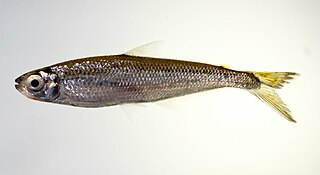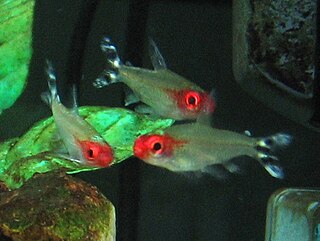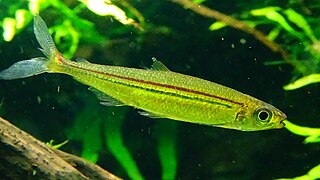
Characidae, the characids or characins is a family of freshwater subtropical and tropical fish, belonging to the order Characiformes. The name "characins" is the historical one, but scientists today tend to prefer "characids" to reflect their status as a by and large monophyletic group at family rank. To arrive there, this family has undergone much systematic and taxonomic change. Among those fishes that remain in the Characidae for the time being are the tetras, comprising the very similar genera Hemigrammus and Hyphessobrycon, as well as a few related forms such as the cave and neon tetras. Fish of this family are important as food and also include popular aquarium fish species.

Tetra is the common name of many small freshwater characiform fishes. Tetras come from Africa, Central America, and South America, belonging to the biological family Characidae and to its former subfamilies Alestidae and Lebiasinidae. The Characidae are distinguished from other fish by the presence of a small adipose fin between the dorsal and caudal fins. Many of these, such as the neon tetra, are brightly colored and easy to keep in captivity. Consequently, they are extremely popular for home aquaria.

Hyphessobrycon is a genus of freshwater fish in the family Characidae. These species are among the fishes known as tetras. The genus is distributed in the Neotropical realm from southern Mexico to Río de la Plata in Argentina. Many of these species are native to South America; about six species are from Central America and a single species, H. compressus is from southern Mexico.

Astyanax is a genus of freshwater fish in the family Characidae of the order Characiformes. Some of these fish, like many of their relatives, are kept as aquarium pets and known collectively as tetras. With around 150 described species and new ones being described yearly, this genus is among the largest of the entire order; Hyphessobrycon also has more than 145 species and which one is larger at any one time depends on whether more species have been recently described in one or the other. The blind and colorless cave tetra of Mexico is a famous member of the genus, but its taxonomic position is disputed: Some recognize it as part of the Mexican tetra and this is supported by phylogenetic evidence, but others recognize the cave form as a separate species, A. jordani.

The rummy-nose tetra is a species of tropical freshwater characin fish originating in South America, popular among fishkeepers as a tropical aquarium fish. One of many small tetras belonging to the same genus, it is on average 5 cm (2 in) long when fully grown. The fish is one of several very similar species including Petitella bleheri, and Petitella georgiae, and it is possible that more recently collected specimens available in the aquarium trade are members of one or other of these similar species. The common name applied to most of these fishes is "rummy-nose tetra", though other common names are in circulation.

Moenkhausia is a genus of freshwater fish in the family Characidae native to tropical and subtropical South America. These are medium-sized tetras where the largest species only reach around 12 cm (4.7 in).

The gold tetra is a species of small freshwater fish in the family Characidae native to lowland South America, where they are abundant in coastal floodplains. Their name comes from a powdery golden tint on their body that is thought to be caused by internal parasites. Gold tetras are peaceful, hardy, schooling community fish. Gold tetras have been successfully bred in captivity.

Hasemania is a genus of characins endemic to Brazil, where only found in river basins that originate on the Brazilian Shield, ranging west to the Juruena system, north to the São Francisco system and south to the Paraná system. The individual species generally have quite small ranges and two, H. crenuchoides and H. piatan, are considered threatened by Brazil's Ministry of the Environment.

Hemigrammus is a genus of freshwater fish in the family Characidae native to South America and commonly seen in the aquarium trade. These are medium-small tetras where the largest species reach up to around 11 cm (4.3 in).

Iguanodectes is a genus of freshwater fish found in tropical South America, with eight currently described species. They are all small tetras, none longer than 5 inches, and often have attractive silvery or striped scales, which makes them a target for the ornamental fish industry. Alongside the genus Piabucus, it is in the subfamily Iguanodectinae, which in turn is in the family Iguanodectidae. The genus Bryconops, which is also in Iguanodectidae, makes up a sister clade to Iguanodectinae.
Petitella georgiae, the false rummy-nose tetra, is a species of characin found in Amazon Basin in Brazil and Peru. It is a very popular aquarium fish. It resembles two species from its genus, Petitella bleheri and Petitella rhodostoma. It is distributed in the upper Amazon basin in Peru, Rio Purus, Rio Negro, and Rio Madeira basins. Some specimens classified as P. georgiae have a black stripe in the caudal peduncle extending forwards into the body, surmounted above by a thin iridescent gold line.

Tetragonopterus is a genus of fish in the family Characidae native to South America.
Jacques Géry was a French ichthyologist and Doctor of Medicine.

Petitella bleheri is a species of characin found in Amazon Basin in Brazil and Peru. One of three species called rummy-nose tetra, but is also called firehead tetra according to FishBase. Reaching a standard length of 2 in (5 cm) it is a common species found in the aquarium trade although often potentially hybridised with the other collective rummy-nose tetra species Petitella rhodostomus and Petitella georgiae; the false rummy-nose tetra.

Carlastyanax aurocaudatus is a small species of freshwater fish in the family Characidae native to the Río Cauca in Colombia. It is the only member of the monotypic genus Carlastyanax, which was named in 1972 specifically for the species by Jacques Géry. Upon description, it was named Astyanax aurocaudatus by Carl H. Eigenmann. There has been debate concerning whether or not the genus should be recognized, but C. aurocaudatus is currently considered a valid species.
Heiko Bleher is a German researcher, author, photographer, and filmmaker. He is best known in the scientific community for his contribution to the exploration of fresh and brackish water habitats worldwide. He has discovered numerous species of fish and aquatic plant, several of which carry his name or are named in honor of Bleher's family.
Hyphessobrycon borealis is a species of tetra in the family Characidae.

Iguanodectidae is a family of freshwater fish in the order Characiformes that lives in South America. It is home to the subfamily Iguanodectinae and the monotypic Bryconops clade. Several species in the family, such as the green line lizard tetra, the tailspot tetra, and the orangefin tetra, are sometimes taken as aquarium fish.

Iguanodectinae is a subfamily of small freshwater fish in the family Iguanodectidae. They are most prominently found in the Amazon river basin and its major tributaries, but they are also known from the Tocantins, Orinoco, and Paraguay rivers. It has two genera, Piabucus and Iguanodectes. Some species in the subfamily are taken from the wild for aquariums, like the red- and green-line lizard tetras. There is minor, but ongoing, debate regarding its taxonomy.

Bryconops melanurus, sometimes called the tail-light tetra, is a small species of freshwater fish from South America that primarily preys on insects. It lives in small schools and is an active swimmer, which means that it requires open space in its habitat. Nonetheless, it does not demonstrate a strong preference for any one biotope within its native range.















